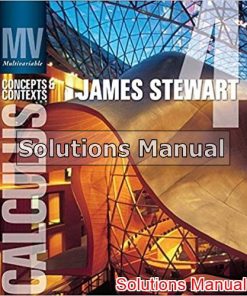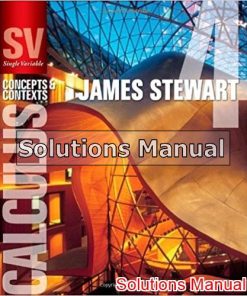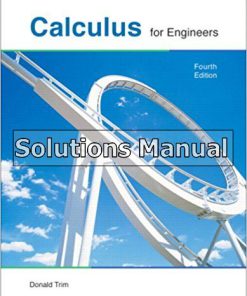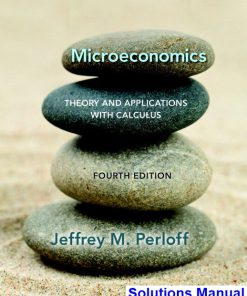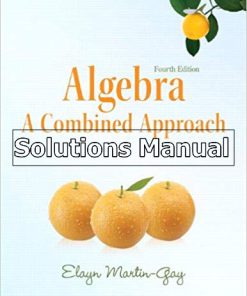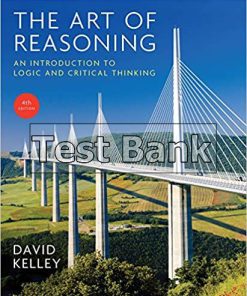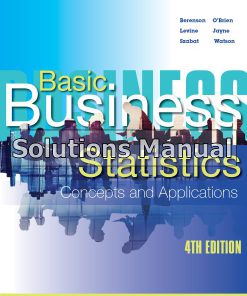Calculus For Biology and Medicine 4th Edition Neuhauser Solutions Manual
$26.50$50.00 (-47%)
Calculus For Biology and Medicine 4th Edition Neuhauser Solutions Manual.
You may also like
This is completed downloadable of Calculus For Biology and Medicine 4th Edition Neuhauser Solutions Manual
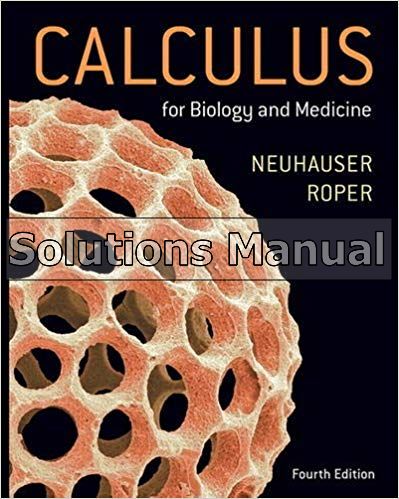
Product Details:
- ISBN-10 : 0134070046
- ISBN-13 : 978-0134070049
- Author: Claudia Neuhauser, Marcus Roper,
Calculus for Biology and Medicine motivates life and health science majors to learn calculus through relevant and strategically placed applications to their chosen fields. It presents the calculus in such a way that the level of rigor can be adjusted to meet the specific needs of the audience ― from a purely applied course to one that matches the rigor of the standard calculus track.
Table of Content:
- Calculus for Biology and Medicine
- Contents
- Preface
- New to This Edition
- Features of the Text
- Reflections and Outlook
- Chapter Summary
- How to Use This Book
- MyLab Math Online Course (access code required)
- Supplements
- Derivatives and Integrals
- Basic Differentiation Rules
- Basic Integration Formulas
- Algebra
- Quadratic Formula
- Factorial notation
- Radicals
- Exponents
- Binomial Formula
- Special Factors
- Geometry
- Distance Formulas
- Equations of Lines and Circles
- Areas and Volumes
- Trigonometry
- Definition of the Six Trigonometric Functions
- MyLab Math for Calculus for Biology and Medicine, 4e (access code required)
- Exercises with Immediate Feedback
- Complete eText
- Questions that Deepen Understanding
- Chapter 1 Preview and Review
- A Brief Overview of Calculus
- Section 1.1 Precalculus Skills Diagnostic Test
- 1.2 Preliminaries
- 1.2.1 The Real Numbers
- Solution
- Solution
- Solution
- 1.2.2 Lines in the Plane
- Solution
- Solution
- 1.2.3 Equation of the Circle
- Solution
- 1.2.4 Trigonometry
- Solution
- 1.2.5 Exponentials and Logarithms
- Solution
- Solution
- Solution
- Solution
- 1.2.6 Complex Numbers and Quadratic Equations
- Solution
- Solution
- Solution
- Solution
- Section 1.2 Problems
- 1.2.1
- 1.2.2
- 1.2.3
- 1.2.4
- 1.2.5
- 1.2.6
- 1.3 Elementary Functions
- 1.3.1 What Is a Function?
- Solution
- Solution
- Solution
- 1.3.2 Polynomial Functions
- Solution
- Solution
- 1.3.3 Rational Functions
- Solution
- 1.3.4 Power Functions
- 1.3.5 Exponential Functions
- Solution
- 1.3.6 Inverse Functions
- Solution
- Geometric Relationship Between f(x) and f−1(x)
- 1.3.7 Logarithmic Functions
- Solution
- Solution
- Solution
- 1.3.8 Trigonometric Functions
- Solution
- Section 1.3 Problems
- 1.3.1
- 1.3.2
- 1.3.3
- 1.3.4
- 1.3.5
- 1.3.6
- 1.3.7
- 1.3.8
- 1.4 Graphing
- 1.4.1 Graphing and Basic Transformations of Functions
- Solution
- Solution
- 1.4.2 The Logarithmic Scale
- Solution
- 1.4.3 Transformations into Linear Functions
- Exponential Functions
- Solution
- Solution
- Power Functions
- Solution
- Solution
- Applications
- Solution
- Solution
- Solution
- 1.4.4 From a Verbal Description to a Graph
- Section 1.4 Problems
- 1.4.1
- 1.4.2
- 1.4.3
- 1.4.4
- Chapter 1 Review
- Key Terms
- Review Problems
- Chapter 2 Discrete-Time Models, Sequences, and Difference Equations
- 2.1 Exponential Growth and Decay
- 2.1.1 Modeling Population Growth in Discrete Time
- Solution
- 2.1.2 Recurrence Equations
- 2.1.3 Visualizing Recurrence Equations
- Nt+1 Against Nt
- Reproductive Rate Against Nt
- Section 2.1 Problems
- 2.1.1
- 2.1.2
- 2.1.3
- 2.2 Sequences
- 2.2.1 What Are Sequences?
- Solution
- Solution
- Solution
- 2.2.2 Using Spreadsheets to Calculate a Recursive Sequence
- 2.2.3 Limits
- Solution
- Solution
- Solution
- Solution
- Formal Definition of Limits
- Solution
- Limit Laws
- Solution
- Solution
- 2.2.4 Recurrence Equations
- Solution
- Solution
- Solution
- 2.2.5 Using Σ Notation to Represent Sums of Sequences
- Solution
- Section 2.2 Problems
- 2.2.1
- 2.2.2
- 2.2.3
- Formal Definition of Limits:
- Formal Definition of Limits:
- 2.2.4
- 2.2.5
- 2.3 Modeling with Recurrence Equations
- 2.3.1 Density-Dependent Population Growth
- Solution
- Solution
- 2.3.2 Density-Dependent Population Growth: The Beverton-Holt Model
- Solution
- 2.3.3 The Discrete Logistic Equation
- 2.3.4 Modeling Drug Absorption
- Solution
- Solution
- Section 2.3 Problems
- 2.3.1
- 2.3.2
- 2.3.3
- 2.3.4
- Chapter 2 Review
- Key Terms
- Review Problems
- Chapter 3 Limits and Continuity
- 3.1 Limits
- 3.1.1 A Non-Rigorous Discussion of Limits
- Solution
- Solution
- Solution
- Solution
- Solution
- 3.1.2 Pitfalls of Finding Limits
- Solution
- Solution
- Solution
- Solution
- 3.1.3 Limit Laws
- Solution
- Solution
- Solution
- Solution
- Solution
- Solution
- Section 3.1 Problems
- 3.1.1 and 3.1.2
- 3.1.3
- 3.2 Continuity
- 3.2.1 What Is Continuity?
- Solution
- Solution
- Solution
- Solution
- Solution
- 3.2.2 Combinations of Continuous Functions
- Proof
- Solution
- Solution
- Solution
- Solution
- Solution
- Solution
- Section 3.2 Problems
- 3.2.1
- 3.2.2
- 3.3 Limits at Infinity
- Solution
- Solution
- Section 3.3 Problems
- 3.4 Trigonometric Limits and the Sandwich Theorem
- 3.4.1 Geometric Argument for Trigonometric Limits
- Proof that limx→01−cosxx=0
- Solution
- 3.4.2 The Sandwich Theorem
- Solution
- Solution
- Proof that limx→0sinxx=1
- Section 3.4 Problems
- 3.4.1
- 3.4.2
- 3.5 Properties of Continuous Functions
- 3.5.1 The Intermediate-Value Theorem and The Bisection Method
- Solution
- Solution
- 3.5.2 Using a Spreadsheet to Implement the Bisection Method
- 3.5.3 A Final Remark on Continuous Functions
- Section 3.5 Problems
- 3.5.1
- 3.5.2
- 3.6 A Formal Definition of Limits
- Solution
- Solution
- Solution
- Solution
- Solution
- Solution
- Section 3.6 Problems
- Chapter 1 Review
- Key Terms
- Review Problems
- Chapter 4 Differentiation
- 4.1 Formal Definition of the Derivative
- Solution
- Section 4.1 Problems
- 4.2 Properties of the Derivative
- 4.2.1 Interpreting the Derivative
- Velocity.
- Population Growth
- The Rate of a Chemical Reaction
- 4.2.2 Differentiability and Continuity
- Proof
- Solution
- Section 4.2 Problems
- 4.2.1
- 4.2.2
- 4.3 The Power Rule, the Basic Rules of Differentiation, and the Derivatives of Polynomials
- Section 4.3 Problems
- 4.4 The Product and Quotient Rules, and the Derivatives of Rational and Power Functions
- 4.4.1 The Product Rule
- Proof
- Solution
- Solution
- Solution
- Solution
- 4.4.2 The Quotient Rule
- Solution
- Solution
- Proof
- Solution
- Solution
- Solution
- Solution
- Solution
- Section 4.4 Problems
- 4.4.1
- 4.4.2
- 4.5 The Chain Rule
- 4.5.1 The Chain Rule
- Solution
- Solution
- Solution
- Solution
- Solution
- Proof of the Quotient Rule
- Solution
- Solution
- Solution
- Solution
- Solution
- Solution
- 4.5.2 Proof of the Chain Rule
- Proof of the Chain Rule
- Section 4.5 Problems
- 4.5.1
- 4.6 Implicit Functions and Implicit Differentiation
- 4.6.1 Implicit Differentiation
- Solution
- Solution
- Solution
- Proof of the Power Rule for Rational Exponents
- 4.6.2 Related Rates
- Solution
- Solution
- Solution
- Section 4.6 Problems
- 4.6.1
- 4.6.2
- 4.7 Higher Derivatives
- Solution
- Solution
- Solution
- Solution
- Solution
- Section 4.7 Problems
- 4.7
- 4.8 Derivatives of Trigonometric Functions
- Section 4.8 Problems
- 4.9 Derivatives of Exponential Functions
- Solution
- Solution
- Solution
- Solution
- Solution
- Solution
- Section 4.9 Problems
- 4.10 Derivatives of Inverse Functions, Logarithmic Functions, and the Inverse Tangent Function
- 4.10.1 Derivatives of Inverse Functions
- Solution
- Solution
- Solution
- Solution
- 4.10.2 The Derivative of the Logarithmic Function
- Solution
- Solution
- Solution
- Solution
- Solution
- Solution
- 4.10.3 Logarithmic Differentiation
- Solution
- Solution
- Proof
- Section 4.10 Problems
- 4.10.1
- 4.10.2
- 4.10.3
- 4.11 Linear Approximation and Error Propagation
- Solution
- Solution
- Solution
- Solution
- Section 4.11 Problems
- Chapter 4 Review
- Key Terms
- Review Problems
- Chapter 5 Applications of Differentiation
- 5.1 Extrema and the Mean-Value Theorem
- 5.1.1 The Extreme-Value Theorem
- Solution
- Solution
- Solution
- 5.1.2 Local Extrema
- Solution
- Solution
- Proof
- Solution
- 5.1.3 The Mean-Value Theorem
- Solution
- Proof of Rolle’s Theorem
- Proof of the MVT
- Solution
- Solution
- Proof of Corollary 2
- Solution
- Section 5.1 Problems
- 5.1.1
- 5.1.2
- 5.1.3
- 5.2 Monotonicity and Concavity
- 5.2.1 Monotonicity
- Proof
- Solution
- Solution
- 5.2.2 Concavity
- Proof
- Solution
- Solution
- Section 5.2 Problems
- 5.2.1 and 5.2.2
- 5.3 Extrema and Inflection Points
- 5.3.1 Extrema
- Solution
- Solution
- Solution
- 5.3.2 Inflection Points
- Solution
- Section 5.3 Problems
- 5.3.1
- 5.3.2
- 5.4 Optimization
- Solution
- Solution
- Solution
- Solution
- Solution
- Section 5.4 Problems
- 5.5 L’Hôpital’s Rule
- Solution
- Solution
- Solution
- Solution
- Solution
- Solution
- 0 ⋅ ∞
- Solution
- Solution
- ∞−∞
- Solution
- Solution
- 00, 1∞, ∞0
- Solution
- Solution
- Section 5.5 Problems
- 5.6 Graphing and Asymptotes
- Solution
- Solution
- Solution
- Solution
- Solution
- Section 5.6 Problems
- 5.7 Recurrence Equations: Stability
- 5.7.1 Exponential Growth
- Cobwebbing
- 5.7.2 Stability: General Case
- Stability
- Proof
- Solution
- Solution
- 5.7.3 Population Growth Models
- Solution
- Solution
- Section 5.7 Problems
- 5.8 Numerical Methods: The Newton–Raphson Method
- Solution
- Solution
- Solution
- Solution
- Section 5.8 Problems
- 5.9 Modeling Biological Systems Using Differential Equations
- 5.9.1 Modeling Population Growth
- 5.9.2 Interpreting the Mathematical Model
- Solution
- Solution
- 5.9.3 Passage of Drugs Through the Human Body
- Solution
- Solution
- Section 5.9 problems
- 5.9.1 and 5.9.2
- 5.9.3
- 5.10 Antiderivatives
- Section 5.10 problems
- Chapter 5 Review
- Key Terms
- Review Problems
- Chapter 6 Integration
- 6.1 The Definite Integral
- 6.1.1 The Area Problem
- 6.1.2 The General Theory of Riemann Integrals
- Solution
- Solution
- Solution
- Solution
- Geometric Interpretation of Definite Integrals
- Solution
- Solution
- Solution
- 6.1.3 Properties of the Riemann Integral
- Proof of (4)
- Proof of (5).
- Solution
- 6.1.4 Order Properties of the Riemann Integral
- Solution
- Solution
- Section 6.1 Problems
- 6.1.1
- 6.1.2
- 6.1.3
- 6.1.4
- 6.2 The Fundamental Theorem of Calculus
- 6.2.1 The Fundamental Theorem of Calculus (Part I)
- Solution
- Solution
- 6.2.2 Leibniz’s Rule and a Rigorous Proof of the Fundamental Theorem of Calculus
- Leibniz’s Rule
- Solution
- Solution
- Solution
- Proof of the Fundamental Theorem of Calculus (Part I) (Optional)
- 6.2.3 Antiderivatives and Indefinite Integrals
- Solution
- Solution
- Solution
- Solution
- Solution
- Solution
- 6.2.4 The Fundamental Theorem of Calculus (Part II)
- Using the FTC (Part II) to Evaluate Definite Integrals.
- Solution
- Solution
- Solution
- Solution
- Solution
- Finding an Integrand
- Solution
- Solution
- Discontinuous Integrand
- Solution
- Section 6.2 Problems
- 6.2.1
- 6.2.2
- 6.2.3
- 6.2.4
- 6.3 Applications of Integration
- 6.3.1 Cumulative Change
- Solution
- Solution
- Solution
- 6.3.2 Average Values
- Solution
- Solution
- Solution
- 6.3.3 The Mean-Value Theorem
- Solution
- Solution
- Proof of the Mean-Value Theorem for Definite Integrals
- 6.3.4 Areas
- Solution
- Solution
- Solution
- 6.3.5 The Volume of a Solid
- Solution
- Solution
- Solution
- Solution
- 6.3.6 Rectification of Curves
- Solution
- Solution
- Solution
- Section 6.3 Problems
- 6.3.1
- 6.3.2
- 6.3.3
- 6.3.4
- 6.3.5
- 6.3.6
- Chapter 6 Review
- Key Terms
- Review Problems
- Chapter 7 Integration Techniques and Computational Methods
- 7.1 The Substitution Rule
- 7.1.1 Indefinite Integrals
- Solution
- Solution
- Solution
- Solution
- Solution
- Solution
- Solution
- 7.1.2 Definite Integrals
- First Way
- Second Way
- Solution
- Solution
- Solution
- Solution
- Solution
- Section 7.1 Problems
- 7.1.1
- 7.1.2
- 7.2 Integration by Parts and Practicing Integration
- 7.2.1 Integration by Parts
- Solution
- Solution
- Solution
- Solution
- Solution
- Solution
- Solution
- 7.2.2 Practicing Integration
- Solution
- Solution
- Solution
- Section 7.2 Problems
- 7.2.1
- 7.2.2
- 7.3 Rational Functions and Partial Fractions
- 7.3.1 Proper Rational Functions
- Solution
- Solution
- 7.3.2 Partial-Fraction Decomposition
- First Method
- Second Method
- Solution
- Solution
- Solution
- 7.3.3 Repeated Linear Factors
- Solution
- Solution
- 7.3.4 Irreducible Quadratic Factors
- Solution
- Solution
- Solution
- Solution
- 7.3.5 Summary
- Case 1a: Q(x) is a product of two distinct linear factors.
- Case 1b: Q(x) is a product of two identical linear factors.
- Case 2: (Optional) Q(x) is an irreducible quadratic polynomial.
- Section 7.3 Problems
- 7.3.1
- 7.3.2
- 7.3.3
- 7.3.4
- 7.3.5
- 7.4 Improper Integrals
- 7.4.1 Type 1: Unbounded Intervals
- Solution
- Solution
- Solution
- Solution
- Solution
- 7.4.2 Type 2: Unbounded Integrand
- Solution
- Solution
- Solution
- 7.4.3 A Comparison Result for Improper Integrals
- Solution
- Solution
- Section 7.4 Problems
- 7.4.1, 7.4.2
- 7.4.3
- 7.5 Numerical Integration
- 7.5.1 The Midpoint Rule
- Solution
- Solution
- 7.5.2 The Trapezoidal Rule
- Solution
- Solution
- 7.5.3 Using a Spreadsheet for Numerical Integration
- Solution
- 7.5.4 Estimating Error in a Numerical Integration
- Section 7.5 Problems
- Sections 7.5.1, 7.5.2
- 7.5.3
- 7.5.4
- 7.6 The Taylor Approximation
- 7.6.1 Taylor Polynomials
- Solution
- Solution
- Solution
- Solution
- 7.6.2 The Taylor Polynomial about x=a
- Solution
- 7.6.3 How Accurate Is the Approximation?
- Solution
- Solution
- Section 7.6 Problems
- 7.6.1
- 7.6.2
- 7.6.3
- 7.7 Tables of Integrals
- Solution
- Solution
- Solution
- Solution
- Solution
- Solution
- Section 7.7 Problems
- Chapter 7 Review
- Key Terms
- Review Problems
- Chapter 8 Differential Equations
- 8.1 Solving Separable Differential Equations
- 8.1.1 Pure-Time Differential Equations
- Solution
- 8.1.2 Autonomous Differential Equations
- Solution
- Solution
- Solution
- Solution
- 8.1.3 General Separable Equations
- Solution
- Section 8.1 Problems
- 8.1.1
- 8.1.2
- 8.1.3
- 8.2 Equilibria and Their Stability
- 8.2.1 Equilibrium Points
- Solution
- Solution
- 8.2.2 Graphical Approach to Finding Equilibria
- 8.2.3 Stability of Equilibrium Points
- Solution
- Solution
- Solution
- Solution
- Solution
- 8.2.4 Sketching Solutions Using the Vector Field Plot
- Solution
- Solution
- 8.2.5 Behavior Near an Equilibrium
- Solution
- Section 8.2 Problems
- 8.2.1
- 8.2.2, 8.2.3
- 8.2.4
- 8.2.5
- 8.3 Differential Equation Models
- 8.3.1 Compartment Models
- 8.3.2 An Ecological Model
- 8.3.3 Modeling a Chemical Reaction
- 8.3.4 The Evolution of Cooperation
- 8.3.5 Epidemic Model
- Section 8.3 Problems
- 8.3.1
- 8.3.2
- 8.3.3
- 8.3.4
- 8.3.5
- 8.4 Integrating Factors and Two-Compartment Models
- 8.4.1 Integrating Factors
- Solution
- Solution
- Solution
- Solution
- 8.4.2 Two-Compartment Models
- Solution
- Solution
- Section 8.4 Problems
- 8.4.1
- 8.4.2
- Chapter 8 Review
- Key Terms
- Review Problems
- Chapter 9 Linear Algebra and Analytic Geometry
- 9.1 Linear Systems
- 9.1.1 Graphical Solution
- Solution
- Solution
- Solution
- 9.1.2 Solving Equations Using Elimination
- Solution
- 9.1.3 Solving Systems of Linear Equations
- Solution
- Solution
- Solution
- Solution
- 9.1.4 Representing Systems of Equations Using Matrices
- Solution
- Solution
- Solution
- Solution
- Section 9.1 Problems
- 9.1.1, 9.1.2
- 9.1.3
- 9.1.4
- 9.2 Matrices
- 9.2.1 Matrix Operations
- Solution
- Solution
- Solution
- 9.2.2 Matrix Multiplication
- Solution
- Solution
- Solution
- Solution
- Solution
- 9.2.3 Inverse Matrices
- Solution
- Solution
- Solution
- Solution
- Solution
- Solution
- 9.2.4 Computing Inverse Matrices
- Solution
- Solution
- Section 9.2 Problems
- 9.2.1, 9.2.2
- 9.2.3
- 9.2.4
- 9.3 Linear Maps, Eigenvectors, and Eigenvalues
- 9.3.1 Graphical Representation
- Vectors
- Solution
- Solution
- Linear Maps
- Solution
- 9.3.2 Eigenvalues and Eigenvectors
- Solution
- Solution
- Solution
- Solution
- Solution
- Solution
- 9.3.3 Iterated Maps (Needed for Section 9.4 and 10.9)
- Solution
- Section 9.3 Problems
- 9.3.1
- 9.3.2
- 9.3.3
- 9.4 Demographic Modeling
- 9.4.1 Modeling with Leslie Matrices
- Solution
- Solution
- 9.4.2 Stable Age Distributions in Demographic Models
- Solution
- Solution
- Section 9.4 Problems
- 9.4.1
- 9.4.2
- 9.5 Analytic Geometry
- 9.5.1 Points and Vectors in Higher Dimensions
- Vector Representation
- Solution
- Length of a Vector
- Solution
- Solution
- 9.5.2 The Dot Product
- Solution
- The Angle between Two Vectors
- Solution
- Solution
- Solution
- Lines in the Plane
- Solution
- Planes in R3
- Solution
- 9.5.3 Parametric Equations of Lines
- Solution
- Solution
- Solution
- Solution
- Section 9.5 Problems
- 9.5.1
- 9.5.2
- 9.5.3
- Chapter 9 Review
- Key Terms
- Review Problems
- Chapter 10 Multivariate Calculus
- 10.1 Functions of Two or More Independent Variables
- 10.1.1 Defining a Function of Two or More Variables
- Solution
- Solution
- Solution
- 10.1.2 The Graph of a Function of Two Independent Variables-Surface Plot
- 10.1.3 Heat Maps
- Solution
- 10.1.4 Contour Plots
- Solution
- Solution
- Section 10.1 Problems
- 10.1.1
- 10.1.2
- 10.1.3
- 10.1.4
- 10.2 Limits and Continuity
- 10.2.1 Informal Definition of Limits
- Limits of Polynomials When the Limits Exist.
- Limits of Rational Functions When the Limits Exist.
- Limits That Do Not Exist.
- Solution
- Solution
- 10.2.2 Continuity
- Solution
- Composition of Functions.
- 10.2.3 Formal Definition of Limits
- Solution
- Section 10.2 Problems
- 10.2.1
- 10.2.2
- 10.2.3
- 10.3 Partial Derivatives
- 10.3.1 Functions of Two Variables
- Solution
- Solution
- Geometric Interpretation.
- Solution
- A Biological Application — Prey Capture
- 10.3.2 Functions of More Than Two Variables
- Solution
- 10.3.3 Higher-Order Partial Derivatives
- Solution
- Section 10.3 Problems
- 10.3.1
- 10.3.2
- 10.3.3
- 10.4 Tangent Planes, Differentiability, and Linearization
- 10.4.1 Functions of Two Variables
- Tangent Planes.
- Solution
- Differentiability.
- Solution
- Solution
- Linearization.
- Solution
- Solution
- 10.4.2 Vector-Valued Functions
- Solution
- Solution
- Solution
- Solution
- Section 10.4 Problems
- 10.4.1
- 10.4.2
- 10.5 The Chain Rule and Implicit Differentiation
- 10.5.1 The Chain Rule for Functions of Two Variables
- Solution
- Solution
- Solution
- 10.5.2 Implicit Differentiation
- Solution
- Solution
- Section 10.5 Problems
- 10.5.1
- 10.5.2
- 10.6 Directional Derivatives and Gradient Vectors
- 10.6.1 Deriving the Directional Derivative
- Deriving the Directional Derivative Using the Chain Rule.
- Deriving the Directional Derivative Without Using the Chain Rule.
- Solution
- Solution
- 10.6.2 Properties of the Gradient Vector
- Solution
- Solution
- Section 10.6 Problems
- 10.6
- 10.7 Maximization and Minimization of Functions
- 10.7.1 Local Maxima and Minima
- Solution
- Solution
- Solution
- Solution
- A Sufficient Condition Based on Eigenvalues (Optional).
- Solution
- Solution
- Solution
- 10.7.2 Global Extrema
- Solution
- Solution
- Solution
- 10.7.3 Extrema with Constraints
- Solution
- Solution
- Solution
- Solution
- 10.7.4 Least-Squares Data Fitting
- Solution
- Solution
- Section 10.7 Problems
- 10.7.1 and 10.7.2
- 10.7.3
- 10.7.4
- 10.8 Diffusion
- Section 10.8 Problems
- 10.8
- 10.9 Systems of Recurrence Equations *
- 10.9.1 A Biological Example
- 10.9.2 Equilibria and Stability in Systems of Linear Recurrence Equations
- Solution
- Solution
- 10.9.3 Equilibria and Stability of Nonlinear Systems of Recurrence Equations
- Solution
- Solution
- Solution
- Solution
- Section 10.9 Problems
- 10.9.1
- 10.9.2
- 10.9.3
- Chapter 10 Review
- Key Terms
- Review Problems
- Chapter 11 Systems of Differential Equations
- 11.1 Linear Systems: Theory
- Solution
- 11.1.1 The Vector Field
- 11.1.2 Solving Linear Systems
- Specific Solutions.
- The General Solution.
- Solution
- 11.1.3 Equilibria and Stability
- 11.1.4 Systems with Complex Conjugate Eigenvalues
- Where Do the Oscillations Come From?
- Solution
- 11.1.5 Summary of the Theory of Linear Systems
- Section 11.1 Problems
- 11.1.1
- 11.1.2
- 11.1.3
- 11.1.4
- 11.1.5
- 11.2 Linear Systems: Applications
- 11.2.1 Two-Compartment Models
- Solving the system when c=d=0
- Solution
- Solution
- Solution
- 11.2.2 A Mathematical Model for Love
- 11.2.3 The Harmonic Oscillator
- Section 11.2 Problems
- 11.2.1
- 11.2.2
- 11.2.3
- 11.3 Nonlinear Autonomous Systems: Theory
- 11.3.1 Analytical Approach
- A Single Autonomous Differential Equation.
- Solution
- Systems of Two Differential Equations.
- Solution
- Solution
- 11.3.2 Graphical Approach for 2×2 Systems
- Solution
- Section 11.3 Problems
- 11.3.1
- 11.3.2
- 11.4 Nonlinear Systems: Lotka–Volterra Model for Interspecific Interactions
- 11.4.1 Competition
- Zero Isoclines.
- Interpreting the Conditions for Coexistence.
- Linearization.
- 11.4.2 A Predator–Prey Model
- Section 11.4 Problems
- 11.4.1
- 11.4.2
- 11.5 More Mathematical Models
- 11.5.1 The Community Matrix
- Mutualism
- Competition
- Commensalism and Amensalism
- Predation
- 11.5.2 Neuron Activity
- 11.5.3 Enzymatic Reactions
- 11.5.4 Microbial Growth in a Chemostat
- 11.5.5 A Model for Epidemics
- Solution
- Solution
- Section 11.5 Problems
- 11.5.1
- 11.5.2
- 11.5.3
- 11.5.4
- 11.5.5
- Lethal Diseases
- Relapsing Infections
- Chapter 11 Review
- Key Terms
- Review Problems
- Chapter 12 Probability and Statistics
- 12.1 Counting
- 12.1.1 The Multiplication Principle
- Solution
- Solution
- 12.1.2 Permutations
- Solution
- Solution
- Solution
- 12.1.3 Combinations
- Solution
- Solution
- 12.1.4 Combining the Counting Principles
- Solution
- Solution
- Solution
- Solution
- Solution
- Solution
- Section 12.1 Problems
- 12.1.1
- 12.1.2
- 12.1.3
- 12.1.4
- 12.2 What Is Probability?
- 12.2.1 Basic Definitions
- Basic Set Operations
- Solution
- The Definition of Probability
- Solution
- Solution
- 12.2.2 Equally Likely Outcomes
- Solution
- Solution
- Solution
- An Application from Genetics
- Solution
- The Mark–Recapture Method
- Solution
- Solution
- Solution
- Section 12.2 Problems
- 12.2.1
- 12.2.2
- Color Blindness
- 12.3 Conditional Probability and Independence
- 12.3.1 Conditional Probability
- Solution
- Solution
- 12.3.2 The Law of Total Probability
- Solution
- Solution
- 12.3.3 Independence
- Solution
- Solution
- Solution
- Solution
- 12.3.4 The Bayes Formula
- Section 12.3 Problems
- 12.3.1
- 12.3.2
- 12.3.3
- 12.3.4
- 12.4 Discrete Random Variables and Discrete Distributions
- 12.4.1 Discrete Distributions
- Solution
- Solution
- 12.4.2 Mean and Variance
- The Average Value, or the Mean, of a Discrete Random Variable
- Solution
- The Variance of a Discrete Random Variable
- Solution
- Solution
- Solution
- Solution
- Solution
- Joint Distributions
- Solution
- Solution
- Solution
- Solution
- Solution
- 12.4.3 The Binomial Distribution
- Solution
- Solution
- Down Syndrome
- Solution
- Solution
- Solution
- Sampling With and Without Replacement.
- Solution
- Solution
- 12.4.4 The Multinomial Distribution
- Solution
- Solution
- 12.4.5 Geometric Distribution
- Solution
- Solution
- Solution
- Solution
- Solution
- 12.4.6 The Poisson Distribution
- Solution
- Solution
- Solution
- Solution
- Solution
- Section 12.4 Problems
- 12.4.1
- 12.4.2
- 12.4.3
- 12.4.4
- 12.4.5
- 12.4.6
- 12.5 Continuous Distributions
- 12.5.1 Density Functions
- Solution
- Solution
- Solution
- Seed Dispersal
- Solution
- 12.5.2 The Normal Distribution
- Solution
- Solution
- Solution
- Using the Table to Find Probabilities
- Solution
- Solution
- Solution
- A Note on Samples
- Solution
- 12.5.3 The Uniform Distribution
- Solution
- Solution
- 12.5.4 The Exponential Distribution
- Solution
- Solution
- Radioactive Decay
- Solution
- Seed Dispersal
- Solution
- Solution
- 12.5.5 The Poisson Process
- Continuation of Example 14
- Solution
- 12.5.6 Aging
- Non-aging
- Solution
- Aging
- Solution
- Fruit Fly Lifetimes
- Solution
- Section12.5 Problems
- 12.5.1
- 12.5.2
- 12.5.3
- 12.5.4
- 12.5.5
- 12.5.6
- 12.6Limit Theorems
- 12.6.1 The Law of Large Numbers
- proof
- proof
- Solution
- Solution
- Solution
- 12.6.2 The Central Limit Theorem
- Solution
- Solution
- Solution
- Solution
- Estimating Sample Sizes
- Solution
- Section12.6 Problems
- 12.6.1
- 12.6.2
- Cystic Fibrosis
- 12.7 Statistical Tools
- 12.7.1 Describing Univariate Data
- Solution
- Solution
- Solution
- 12.7.2 Estimating Parameters
- Point Estimates of Means
- Solution
- A Remark on Using the Sample Mean to Estimate the Mean
- Point Estimates of Proportions
- Solution
- Solution
- Point Estimates of Variances
- Solution
- Confidence Intervals
- Solution
- Solution
- Solution
- Interpreting Mean±S.E.
- Solution
- 12.7.3 Linear Regression
- Solution
- Solution
- Section12.7 Problems
- 12.7.1
- 12.7.2
- 12.7.3
- Chapter 1 Review
- Key Terms
- Review Problems
- Appendices
- Answers to Odd-Numbered Problems
- Section 1.1 (Includes Even-Numbered Problems)
- Section 1.2
- Section 1.3
- Section 1.4
- Chapter 1 Review Problems
- Section 2.1
- Section 2.2
- Section 2.3
- Chapter 2 Review Problems
- Section 3.1
- Section 3.2
- Section 3.3
- Section 3.4
- Section 3.5
- Section 3.6
- Chapter 3 Review Problems
- Section 4.1
- Section 4.2
- Section 4.3
- Section 4.4
- Section 4.5
- Section 4.6
- Section 4.7
- Section 4.8
- Section 4.9
- Section 4.10
- Section 4.11
- Chapter 4 Review Problems
- Section 5.1
- Section 5.2
- Section 5.3
- Section 5.4
- Section 5.5
- Section 5.6
- Section 5.7
- Section 5.8
- Section 5.9
- Section 5.10
- Chapter 5 Review Problems
- Section 6.1
- Section 6.2
- Section 6.3
- Chapter 6 Review Problems
- Section 7.1
- Section 7.2
- Section 7.3
- Section 7.4
- Section 7.5
- Section 7.6
- Section 7.7
- Chapter 7 ReviewProblems
- Section 8.1
- Section 8.2
- Section 8.3
- Section 8.4
- Chapter 8 Review Problems
- Section 9.1
- Section 9.2
- Section 9.3
- Section 9.4
- Section 9.5
- Chapter 9 Review Problems
- Section 10.1
- Section 10.2
- Section 10.3
- Section 10.4
- Section 10.5
- Section 10.6
- Section 10.7
- Section 10.8
- Section 10.9
- Chapter 10 Review Problems
- Section 11.1
- Section 11.2
- Section 11.3
- Section 11.4
- Section 11.5
- Chapter 11 Review Problems
- Section 12.1
- Section 12.2
- Section 12.3
- Section 12.4
- Section 12.5
- Section 12.6
- Section 12.7
- Chapter 12 Review Problems
- References
- Index
- A
- B
- C
- D
- E
- F
- G
- H
- I
- J
- K
- L
- M
- N
- O
- P
- Q
- R
- S
- T
- U
- V
- W
- Y
- Z
People Also Search:
calculus for biology and medicine neuhauser
calculus for biology and medicine 4th edition neuhauser
calculus for biology and medicine 4th edition
calculus for biology and medicine 4th edition download scribd
calculus for biology and medicine 4th edition solution manual download pdf

